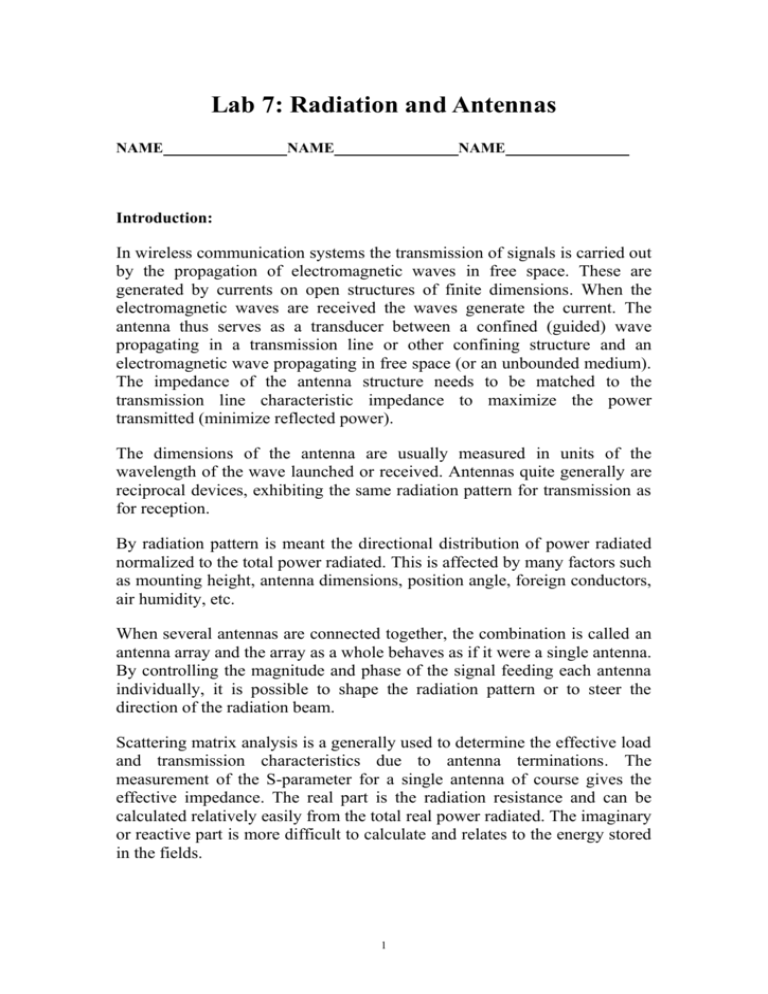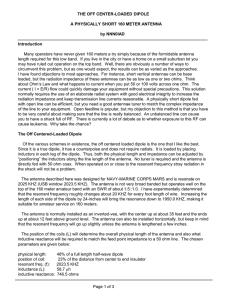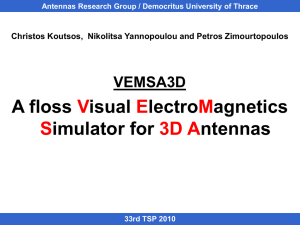Lab 7: Radiation and Antennas
advertisement

Lab 7: Radiation and Antennas NAME NAME NAME Introduction: In wireless communication systems the transmission of signals is carried out by the propagation of electromagnetic waves in free space. These are generated by currents on open structures of finite dimensions. When the electromagnetic waves are received the waves generate the current. The antenna thus serves as a transducer between a confined (guided) wave propagating in a transmission line or other confining structure and an electromagnetic wave propagating in free space (or an unbounded medium). The impedance of the antenna structure needs to be matched to the transmission line characteristic impedance to maximize the power transmitted (minimize reflected power). The dimensions of the antenna are usually measured in units of the wavelength of the wave launched or received. Antennas quite generally are reciprocal devices, exhibiting the same radiation pattern for transmission as for reception. By radiation pattern is meant the directional distribution of power radiated normalized to the total power radiated. This is affected by many factors such as mounting height, antenna dimensions, position angle, foreign conductors, air humidity, etc. When several antennas are connected together, the combination is called an antenna array and the array as a whole behaves as if it were a single antenna. By controlling the magnitude and phase of the signal feeding each antenna individually, it is possible to shape the radiation pattern or to steer the direction of the radiation beam. Scattering matrix analysis is a generally used to determine the effective load and transmission characteristics due to antenna terminations. The measurement of the S-parameter for a single antenna of course gives the effective impedance. The real part is the radiation resistance and can be calculated relatively easily from the total real power radiated. The imaginary or reactive part is more difficult to calculate and relates to the energy stored in the fields. 1 In this lab we will in particular use a vertical antenna (z-direction) with a ground plane connected to a coaxial cable. This antenna thus has a vertical current distribution. From class we know that the vector potential is thus along the antenna. The radiative fields (the 1/r fields where r is the radial distance from the antenna and r is much greater than a few wavelengths) thus have an axial magnetic field component and a electric field component (angle with respect to the z-axis). The second antenna we will use is the coil. If z is perpendicular to the plane of the coil, then the vector potential is axial (around the z-axis) and the relevant radiative field components are a magnetic field in the direction and an electric field in the axial direction (around the z-axis). A short linear antenna is known as an electric dipole antenna and the small radius coil antenna is the magnetic dipole antenna. As we make these longer and of greater radius respectively, higher order multipoles are added. The antenna directional characteristics change as well as the impedances we measure. For the short electric and magnetic dipoles all the radiative field components vary as sin and 1/ r . Thus the radiated intensity varies as (sin ) 2 / r 2 . We wish to check this for both the antennas. (sin ) 2 / r 2 Furthermore if we integrate over a sphere of radius r we obtain a constant in dependent of r . If we consider the amplitudes of the magnetic and electric fields for the short linear dipole (see the text –short dipole) this power is given by Prad 40 2 I o2 (l / ) where I0 is the current amplitude on the short linear antenna and is its length. If we equate this to 2 I 0 Rrad /2 we obtain a well-known expression for the antenna resistance Rrad 80 2 (l / )2 For a center-fed short dipole or a dipole above a ground plane the length is the total length (dipole plus image in the latter case). For a center-fed longer 2 antenna (or one above a ground plane) the current amplitude is more accurately triangular, a maximum at the excitation point and zero at the end. The effective length is then half the physical length and thus the antenna resistance is Rrad 20 2 (l / )2 In this lab, we wish to demonstrate: a) The 1/ r 2 behavior of the radiated intensity. b) The (sin ) 2 angular dependence of the radiation pattern. c) The polarization characteristics of the dipole antennas d) The determination of antenna impedance. Proceedure: There are two alternatives. You can select which to use. The choices are A) A national instruments signal generator spectrum analyzer combination. 1) To use this after you login to your account go to c:\examples\instr\ni5660 2) You want to use RFSG (radio frequency signal generator) – this consists of the 5441 baseband signal generator and the 5610 up-convertor. The script is simplescript.vi . In the upper left hand corner there is a tab for resource name. This should be Up Conversion 3) For the spectrum analyzer you can use the getting started spectrum.vi script or the demo panel.vi 4) You will see a tab for resource name- This should be Down Conversion 5) Connect the transmitting antenna to RFOUT from the RFSG 5441 6) Connect the receiving antenna to the input to the RFSA. 7) A transmitting power of -2 dBm should suffice. Use a frequency of about 1GHz on the signal generator and scan the spectrum analyzer from about 800 MHz to 1.2 GHz B) The second choice is to use an Agilent signal generator (N5181A) and an Agilent E4402B Spectrum analyzer. These operate in the conventional way and should offer little problem in getting the signal 3 generator to give a signal at about 1 GHz and the spectrum analyzer to scan over the range of 800 MHz to about 1. 5 GHz Measurements 1) Once you have the transmitter and receiver operational demonstrate a) of page 2 by measuring the signal received as a function of antenna separation for the linear antenna keeping the antennas oriented in parallel. 2) Demonstrate the (sin ) 2 dependence by fixing the receiving antenna vertically and rotating the transmitting antenna in keeping the linear antennas in the same plane ( r ) and the transmitting antenna axis perpendicular to r. Here z is the orientation axis of the receiving antenna, 𝑟 is the radial distance from the receiving antenna and 𝜃 , the angle between z and 𝑟. Sketch the radiation pattern on the graph provided below. Please label the radius in dB. 3) Check the polarization characteristics by orienting the transmitting antenna perpendicular to the r plane. Is the signal largest for the antenna axes oriented parallel or perpendicular? 4) Do the same (procedures 1) to 3) ) for a pair of loop antennas. You need not plot the spatial pattern in this case since it will mimic the above. 5) Now check the relative polarization of the magnetic dipole and the electric dipole antennas by using one as the transmitter and the other as the 4 receiver. The electric field is in the plane r z plane for the electric dipole. You can also use the course grating provided to check the polarization. Which electric field polarization would you expect to have the highest reflectivity off the course grating? 6) Use a network analyzer to determine S11 for one of the linear and one of the loop antennas as a function of frequency. Does the linear dipole come close to the expression on page 2? To check this determine at what frequency 𝑆11 is a nearly zero. This corresponds to 50 Ohms the input resistance of the spectrum analyzer. Now use the 𝑅𝑟𝑎𝑑 equation to calculate the length. Compare this with the physical length. Are they in agreement? 7) Were these measurements made in the near-field or the far field of the antennas? What is the evidence for your answer? How far should the transmitting and receiving antennas be to guarantee that they are in the far-field? 5




